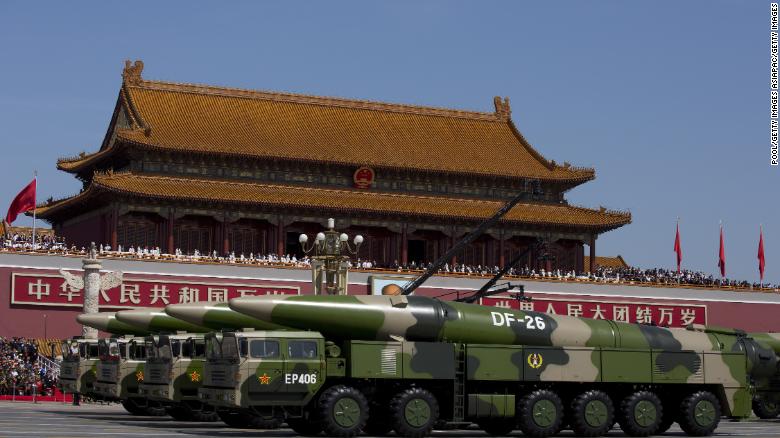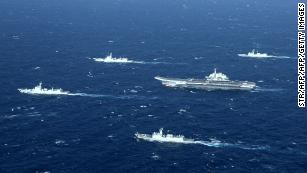September 22, 2019
Hong Kong (CNN)The US military is no longer the primary force in Asia, and missiles from China‘s rapidly improving military could overwhelm its bases in hours, according to a new report.
The study by the United States Study Center, at the University of Sydney, in Australia, warned that America’s defense strategy in the Indo-Pacific region “is in the throes of an unprecedented crisis” and could struggle to defend its allies against China.
That means Australia, Japan and other US partners need to build up and refocus their forces in the region, and consider increased cooperation with the US, to ensure their security, the study claimed.
The report highlights areas where China’s military is making huge strides in comparison to the US and its Asian allies and partners. Chief among those is in missiles.
“China has deployed a formidable array of precision missiles and other counter-intervention systems to undercut America’s military primacy,” the report states. Those missiles number in the thousands, the report says.
Almost all US military installations in the Western Pacific, as well as those of its key partners and allies, “could be rendered useless by precision strikes in the opening hours of a conflict,” according to the report.
China’s Foreign Ministry said Monday it had not seen the report, but spokesperson Geng Shuang stressed that the country’s military policy was “defensive in nature.”
“China is firmly on a path of peaceful development and our national defense policy is defensive in nature,” Geng said.
CNN reached out to the Pentagon for comment but had not heard back at the time of publication.
Little surprise
Much of the Australian report should come as little surprise to the Pentagon.
A November 2018 report to Congress from the National Defense Strategy Commission said “the US military could suffer unacceptably high casualties” and “might struggle to win or perhaps lose, a war against China or Russia.”
Six months later, the US Defense Department’s annual report on China’s military said Beijing was intent on developing a world-class military and becoming “the preeminent power in the Indo-Pacific region.”

Chinese military vehicles carrying DF-26 ballistic missiles drive are seen during a 2015 military parade in Beijing.
Upwards of 2,000 short-, medium- and intermediate-range ballistic missiles that can hit land and sea targets are part of that plan, according to the Pentagon report.
The Australian study questions the US’s ability to keep up with China’s advances, and warns that Washington is facing a crisis of “strategic insolvency.”
For example, the US is seeing its fleet of nuclear-powered attack submarines shrinking at a time when they are needed even more.
“Put simply, as the environment above the surface becomes more deadly because of Chinese deployments of cruise missiles, hypersonic technologies and anti-air defenses, America’s enduring advantage in undersea warfare will become increasingly important in the regional balance of power,” the report says.
But Adm. Phil Davidson, the head of the US Indo-Pacific Command, told Congress in March that he was only getting half of the submarines needed in the Pacific on a daily basis.
The Australian report says it is critical that Canberra and partners like Japan need to step up to fill the voids the US is leaving.
“Washington will require significant and ongoing support from its regional allies and partners to successfully deter Chinese adventurism,” it said.
The report, for example, suggested that Australia increase its production of conventionally powered submarines, which are ideal for operations close to coastlines or in areas like the South China Sea.
It also encouraged “collective defense” through software that enables communications between allies.
Working together
Increased cooperation between the US and its allies is already happening.
The US and Australia recently completed their biennial Talisman Sabre exercises in northern Australia, which this year also included a bulked-up Japan Self-Defense Force contingent performing two amphibious landings.
The Australian report said more of the same is needed, and farther afield from Australia.
“Exercises should practice and demonstrate rapid dispersal of air- and land-based strike forces from concentrated basing in mainland Japan, Okinawa and Guam, to small geographically diverse operating locations (around the South China Sea),” it said.
“The primary aim of such exercises should be to bolster the collective ability to deter, deny and, if necessary, blunt potential Chinese fait accompli aggression,” it said.
The report noted that the Australian military is beset by one of the same ills hurting its American allies — spreading its forces too thinly. Between 2001 and 2018, Australia spent more than three times as much on operations in the Middle East than it did in the Indo-Pacific.
The strain that conflicts in Afghanistan, Iraq and Syria have placed on the US military’s budget, equipment and operations had “ill-prepared” Washington “for great power competition in the Indo-Pacific,” it said.
Studie: USA in Asien nicht mehr Militärmacht Nr. 1
Nicht nur die Tatsache, dass der Iran gemeinsam mit Russland ein Manöver im Indischen Ozean plant sollte hinsichtlich der Dominanz der Vereinigten Staaten auf diesem Gebiet zu denken geben. Auch die Einschätzungen einer australischen Studie, die aus verschiedenen Gründen gar China an der Weltmacht Nr.1 vorbei ziehen sieht, kommen zu einem – aus amerikanischer Sicht – vernichtenden Ergebnis.
- 06.09.2019

Die Universität Sydney publizierte kürzlich eine Studie, wonach die USA in Asien nicht mehr die Militärmacht Nr.1 sind.
Diesen Rang hat inzwischen die Volksrepublik China eingenommen. Die US-Streitkräfte leiden an dem Syndrom des “overstretch”, der “Überdehnung”, als Folge der weltweiten Präsenz, vor allem aber der Verwicklung in ungezählte Regionalkonflikte, die nicht selten von Washington selbst entfacht wurden.
Besorgniserregend für die Strategen in Washington dürfte diesbezüglich vor allem die Tatsache sein, dass die USA fast so viel Geld in ihren Militäretat investieren, wie die folgenden acht Staaten: China, Saudi-Arabien, Indien, Frankreich, Russland, Großbritannien, Deutschland und Japan zusammen. Trotzdem wächst der militärische Einfluss Pekings ungebremst.
2018 gab die Volksrepublik etwa 250 Milliarden US-Dollar im Bereich der Verteidigung aus, wobei die chinesischen Militärausgaben seit einem Vierteljahrhundert wachsen. Die Verfasser der australischen Studie analysieren, dass sich die US-Verteidigungsstrategie in der Indopazifischen Region, also in der weltweit bevölkerungsreichsten Gegend, in eine Sackgasse manövriert hat.
USA nicht mehr in der Lage, die asiatischen Verbündeten gegen China zu verteidigen
Gemäß der Verfasser der Studie könnten die USA es künftig schwer haben, ihre Alliierten in diesem geopolitischen Raum gegen China zu verteidigen. Das chinesische Raketensystem, genauer Pekings Arsenal an Präzisionsraketen hat die militärische Vorherrschaft der USA ausgehebelt.
Vernichtung in den ersten Stunden
Demzufolge würden alle Militärbasen der USA und ihrer Verbündeten in den ersten Stunden einer militärischen Auseinandersetzung vernichtet werden, inklusive hoher Verluste des US-Militärs.
„USA können mit China nicht mithalten“
Zu Beginn dieses Jahres hatte das US-Verteidigungsministerium in seinem jährlichen China-Bericht davor gewarnt, dass Peking die Absicht habe, „eine Streitmacht der Weltklasse“ zu entwickeln und die „herausragende Militärmacht in der Indopazifischen Region“ zu werden. Über 2.000 Kurz-, Mittel- und Langstreckenraketen, die Ziele an Land und auf See treffen können, sind Bestandteil dieser Planung, heißt es in dem Bericht.
USA vor einer Krise der militärischen Insolvenz
Die australische Studie warnt, dass die USA vor einer Krise der „militärischen Insolvenz“ steht. Aufgrund der Tatsache, dass Chinas Arsenal vor allem auf „Attacken von der Oberfläche auf die Oberfläche“ setze, sei eine mächtige Unterwasserflotte strategisch wichtiger denn je, schlussfolgerten die Verfasser.
Russisch-Iranische Manöver im Indischen Ozean
Das Schwinden der US-Dominanz in der Region lässt sich auch daran erkennen, dass Russland und Iran ein gemeinsames Marinemanöver im Indischen Ozean vorbereiten. Dies berichtet die russische Nachrichtenagentur TASS. Die Außenminister Moskaus und Teherans, Sarif und Lawrow, betrachten dies als Beitrag zur Entspannung in der Region.
Fazit
Das chinesische Militär befindet sich zweifelsohne auf der Überholspur, getragen unter Anderem von der massiv gestiegenen ballistischen Kompetenz der Volksbefreiungsarmee. Die USA, die sicherlich noch immer in der Lage sind, ihre Truppen weltweit innerhalb von 24 Stunden zu mobilisieren, befinden sich schon in dem Prozess der Überdehnung, welcher den Fall großer Imperien begleitet.
https://www.cashkurs.com/gesellschaft-und-politik/beitrag/studie-usa-in-asien-nicht-mehr-militaermacht-nr-1/
https://www.cashkurs.com/gesellschaft-und-politik/beitrag/studie-usa-in-asien-nicht-mehr-militaermacht-nr-1/

